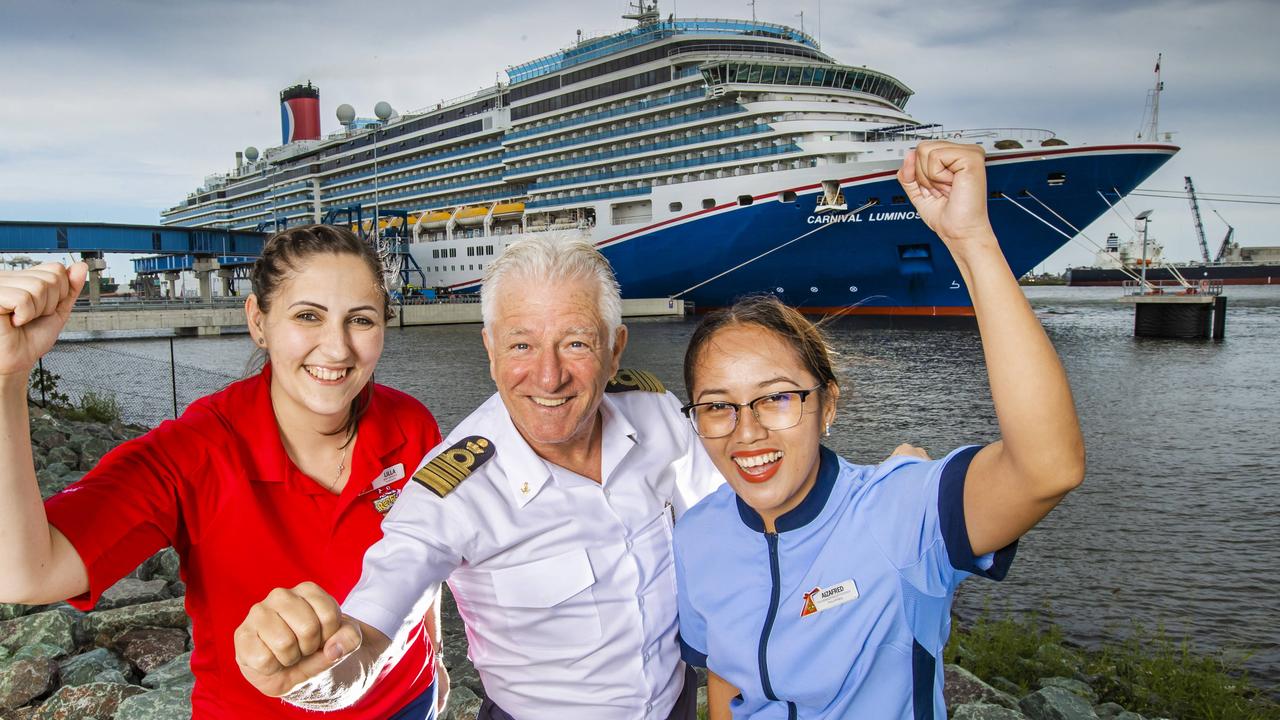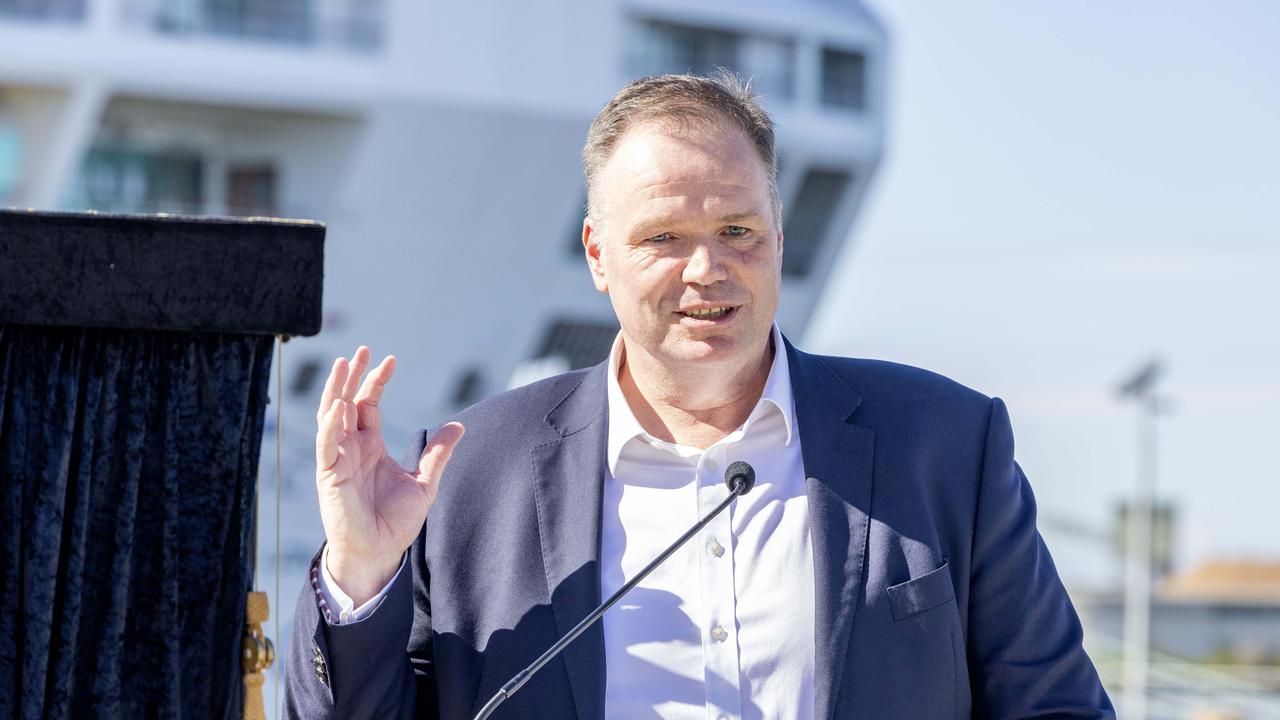Brisbane’s new $180m cruise terminal eyes expansion ahead of 2032 Olympics
Brisbane’s $180m cruise terminal may need to be expanded sooner rather than later to cope with a surge in ship visits leading up to the 2032 Olympics.
Business
Don't miss out on the headlines from Business. Followed categories will be added to My News.
Brisbane’s $180m cruise terminal may need to be expanded sooner rather than later to cope with a surge in ship visits leading up to the 2032 Olympics.
Port of Brisbane chief executive Neil Stephens says the Brisbane International Cruise Terminal, which was mothballed for 18 months soon after it opened in 2020, was now among the busiest areas of the port with 160 ship visits so far this cruising season.
“We are easily back to pre-Covid levels,” says Stephens. “Each one of those visits by a cruise ship, which have between 3000 and 4500 passengers, is a mini economic boom that pumps about $1m into the local economy.”
Stephens says that even during the darkest days of the pandemic “we never lost faith in the asset.” He says the port was now doing some initial investigations into expanding the terminal so it could handle more than one ship at a time.
“There will come a day when we have to look at expanding,” says Stephens. “There is only one berth at the moment and ideally we would like one more.
“The terminal can now take the largest cruise ships in the world up to 350 metres and in the lead up to the 2032 Olympics there will be more demand.”
The resumption of ship visits to the port has rekindled plans to make Queensland the cruise capital of the country.

Queensland has more ports than any other Australian state, with exotic destinations including Moreton Island, the Whitsundays and the Great Barrier Reef.
Australians are the most ardent cruisers in the world and Queensland, behind Sydney, was the second biggest market in the country.
Stephens tells City Beat that other parts of the port also are booming, with record container trade this year as well as increasing shipments of grains, cotton and beef.
Despite significant disruption due to Covid-19 and severe weather, a record 1.53m twenty-foot equivalent units (TEUs) of containers went through the port in the 2022 financial year.
Initial fears the “world was about to end” due to the Covid-19 pandemic, was misplaced with the port experiencing record trading in a range of commodities and products.
“It has all come back -everything from sorghum, beef, cotton and chick peas - has increased,” says Stephens, who was appointed chief executive in March. “The only area where we have seen some challenges is in cars.”
Stephen says other challenges for the port remain including the lack of a dedicated rail connection to the port when the Melbourne to Brisbane Inland Rail is completed.
Currently only 1 per cent of container freight goes by rail, compared to between 15 and 20 per cent in Sydney and Melbourne, meaning more trucks on local roads.
A major impediment is that freight being railed to the port has to share capacity with the Brisbane suburban passenger network. “There are blackout periods when the suburban trains are rightly given priority,” he says. Stephens says that while both federal and state governments have pitched in a combined $40m to develop a business case for the connection, those funds have yet to be spent.

A report by Deloitte Access Economics this year found the Port of Brisbane and its supply chain contributed approximately $7.8 billion to the Queensland economy and supported almost 63,000 jobs. This includes 7,900 jobs directly supported within the Port of Brisbane precinct. Over time, this contribution will continue to grow and by 2032, the port could contribute $9.9 billion in economic value added and support 80,200 job. By 2050, the port could contribute $15.4 billion in economic value added and support 124,400 jobs.
Master Apprentice
Brown and Hurley’s Hunter Tapping has done himself and his company proud after picking up the Heavy Vehicle Industry Awards (HVIA) Apprentice of the Year award last week in Brisbane. Tapping, from Yatala, and fellow Brown and Hurley apprentice Simon Flynn, from Kyogle, were up for the national award. Tapping, 22, is a qualified heavy diesel mechanic and has been involved in the industry since he left school aged 17. He has been with Brown and Hurley, one of the country’s largest truck dealerships, for five years and says he “has not looked back.” I’ve always had a passion for the industry and aim to for many years to come,” Tapping says. “I love the wide range of jobs in the workshop, whether it be a clutch, transmission or engine rebuild, there is always something different and always plenty to learn.” He says he also enjoys participating in the on call after hours breakdown roster, where he can be called out at any time of night to attend a broken-down truck to keep customers happy and the freight moving.

Domino’s expansion
Domino’s will open another 10 stores across Australia and New Zealand by the end of December with 40 new stores planned before the end of the financial year.
The Brisbane-based company recently surpassed 900 stores in the region, including 750 stores in Australia, and will celebrate the opening of its 150th store in New Zealand this month. This acceleration of growth has seen Domino’s set a goal to expand its store network to 1000 stores across Australia and New Zealand in 2024.
Domino’s ANZ chief development officer Cameron Toomey says the company has almost 40 years of experience operating in the Australian market, and 20 in New
Zealand. “It’s this knowledge that gives us confidence to bring more Domino’s kitchens
closer to more customers across these established regions,” says Toomey.
“For Domino’s ANZ development team, we have shifted our focus from delivering the
standard Domino’s store in a typical, metro location, to also developing bespoke stores to
get us into locations that we have not serviced, and which other large quick service
restaurant chains do not reach.”

On the buses
Transport giant Transit Systems has acquired North Stradbroke Island Buses, its first bus service in Queensland.
Transit Systems chief operating officer Greg Balkin says the new acquisition perfectly complements its existing operations. “We’re proud to add the North Stradbroke Island Buses fleet to our growing portfolio of over 3200 buses in Australia, while creating new opportunities for growth in the Sunshine State,” says Balkin. The Brisbane headquartered firm already operates the Brisbane City Council Ferry Network.
Transit Systems is part of Kelsian Group, which also owns SeaLink Marine and Tourism, operating locally as SeaLink South East Queensland and responsible for the Stradbroke Ferries service, Southern Moreton Bay Island Ferry network and the Moggill Vehicular Ferry service. “We will provide the community on North Stradbroke Island with a truly seamless transition from ferry to bus and back,” he says. “We see this as a very strategic step to grow our portfolio in Queensland as our ferry services and bus operations continue to expand.”
More Coverage
Originally published as Brisbane’s new $180m cruise terminal eyes expansion ahead of 2032 Olympics









